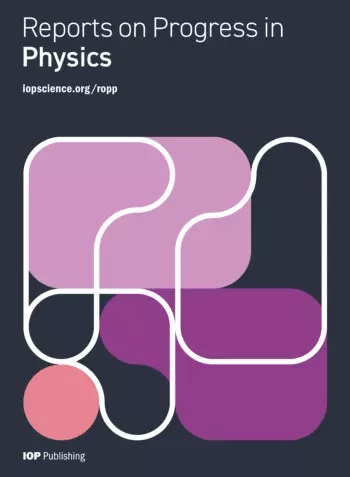Gravity generated by four one-dimensional unitary gauge symmetries and the Standard Model
IF 20.7
1区 物理与天体物理
Q1 PHYSICS, MULTIDISCIPLINARY
引用次数: 0
Abstract
The Standard Model of particle physics describes electromagnetic, weak, and strong interactions, which are three of the four known fundamental forces of nature. The unification of the fourth interaction, gravity, with the Standard Model has been challenging due to incompatibilities of the underlying theories—general relativity and quantum field theory. While quantum field theory utilizes compact, finite-dimensional symmetries associated with the internal degrees of freedom of quantum fields, general relativity is based on noncompact, infinite-dimensional external space-time symmetries. The present work aims at deriving the gauge theory of gravity using compact, finite-dimensional symmetries in a way that resembles the formulation of the fundamental interactions of the Standard Model. For our eight-spinor representation of the Lagrangian, we define a quantity, called the space-time dimension field, which enables extracting four-dimensional space-time quantities from the eight-dimensional spinors. Four U(1) symmetries of the components of the space-time dimension field are used to derive a gauge theory, called unified gravity. The stress-energy-momentum tensor source term of gravity follows directly from these symmetries. The metric tensor enters in unified gravity through geometric conditions. We show how the teleparallel equivalent of general relativity in the Weitzenböck gauge is obtained from unified gravity by a gravity-gauge-field-dependent geometric condition. Unified gravity also enables a gravity-gauge-field-independent geometric condition that leads to an exact description of gravity in the Minkowski metric. This differs from the use of metric in general relativity, where the metric depends on the gravitational field by definition. Based on the Minkowski metric, unified gravity allows us to describe gravity within a single coherent mathematical framework together with the quantum fields of all fundamental interactions of the Standard Model. We present the Feynman rules for unified gravity and study the renormalizability and radiative corrections of the theory at one-loop order. The equivalence principle is formulated by requiring that the renormalized values of the inertial and gravitational masses are equal. In contrast to previous gauge theories of gravity, all infinities that are encountered in the calculations of loop diagrams can be absorbed by the redefinition of the small number of parameters of the theory in the same way as in the gauge theories of the Standard Model. This result and our observation that unified gravity fulfills the Becchi–Rouet–Stora–Tyutin (BRST) symmetry and its coupling constant is dimensionless suggest that unified gravity can provide the basis for a complete, renormalizable theory of quantum gravity.由四个一维酉规对称和标准模型产生的重力
粒子物理学的标准模型描述了电磁、弱和强相互作用,它们是四种已知的自然基本力中的三种。由于基础理论——广义相对论和量子场论的不兼容性,第四种相互作用——引力——与标准模型的统一一直具有挑战性。量子场论利用与量子场的内部自由度相关的紧致的有限维对称性,而广义相对论则基于非紧致的无限维外部时空对称性。目前的工作旨在以一种类似于标准模型基本相互作用公式的方式,利用紧凑的有限维对称性推导引力规范理论。对于拉格朗日量的八旋量表示,我们定义了一个量,称为时空维度场,它可以从八维旋量中提取四维时空量。时空维度场组成部分的四个U(1)对称性被用来推导一个规范理论,称为统一引力。重力的应力-能量-动量张量源项直接从这些对称性推导出来。度规张量通过几何条件进入统一引力。我们展示了在Weitzenböck规范中广义相对论的远平行等效是如何通过一个依赖于重力场的几何条件从统一引力中获得的。统一重力还使重力测量场无关的几何条件,导致在闵可夫斯基度规重力的精确描述。这与广义相对论中度规的使用不同,在广义相对论中,度规取决于引力场的定义。基于闵可夫斯基度规,统一引力使我们能够在一个统一的数学框架内描述引力,以及标准模型中所有基本相互作用的量子场。我们提出了统一重力的费曼规则,并研究了该理论在单环阶上的重整性和辐射修正。等效原理是通过要求惯性质量和引力质量的重归一化值相等来表述的。与先前的引力规范理论相比,环路图计算中遇到的所有无限大都可以通过重新定义理论的少量参数来吸收,就像在标准模型的规范理论中一样。这一结果和我们对统一引力满足Becchi-Rouet-Stora-Tyutin (BRST)对称性及其耦合常数是无因次的观测表明,统一引力可以为一个完整的、可重整的量子引力理论提供基础。
本文章由计算机程序翻译,如有差异,请以英文原文为准。
求助全文
约1分钟内获得全文
求助全文
来源期刊

Reports on Progress in Physics
物理-物理:综合
CiteScore
31.90
自引率
0.00%
发文量
45
审稿时长
6-12 weeks
期刊介绍:
Reports on Progress in Physics is a highly selective journal with a mission to publish ground-breaking new research and authoritative invited reviews of the highest quality and significance across all areas of physics and related areas. Articles must be essential reading for specialists, and likely to be of broader multidisciplinary interest with the expectation for long-term scientific impact and influence on the current state and/or future direction of a field.
 求助内容:
求助内容: 应助结果提醒方式:
应助结果提醒方式:


